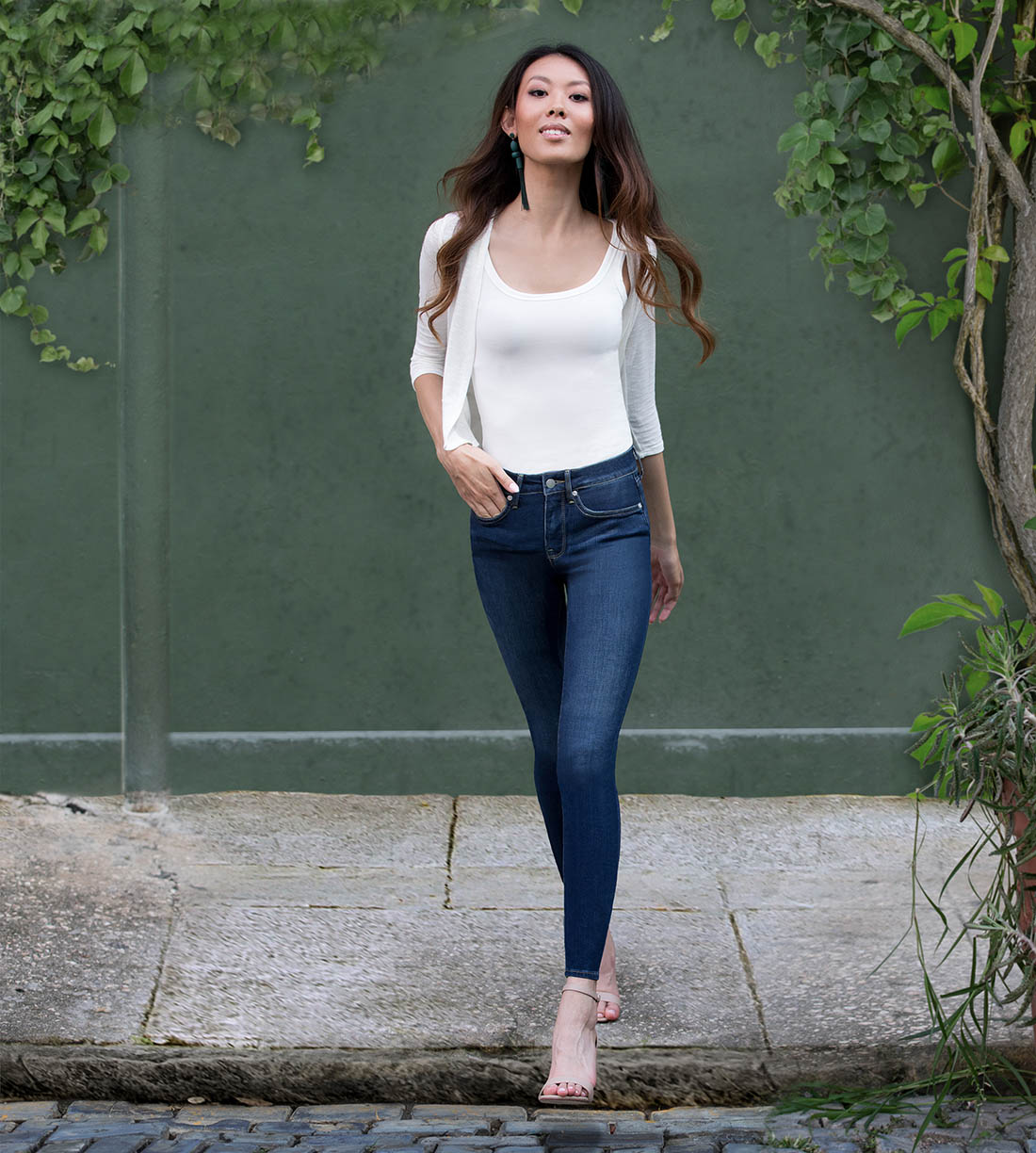Although not all fabrics need elastane to be stretchable, innovative and more sustainable alternatives are now available on the market
Elastane – spandex or Lycra to many people – is a synthetic fiber known for its exceptional elasticity; it is, however, non-biodegradable.
Elastane is used in fabrics to impart stretch properties, providing comfort and enhancing the appearance of garments. But with biodegradability issues coming more to the fore as part of wider consumer concerns about the environmental impact of textiles, producers are now launching sustainable stretch variants and seeking to develop new, sustainable options for fiber feedstocks.
Properties
An elastic polyurethane material, elastane fibers can stretch up to 500% of – and then return to – their original shape and length. They can withstand this process numerous times before eventually losing their ability to maintain their shape.
As well as its inherent elastic properties, elastane can also be blended in small amounts (typically 1–5%) with other fibers, such as polyester, polyamide, cotton or wool. This increases the fabric’s ability to stretch considerably, enabling the creation of form-fitting and highly durable garments, and elastane is principally used in blends for hosiery, underwear and other close-fitting clothing.
Moreover, elastane is lightweight and resistant to abrasion, ultraviolet (UV) light, chlorine and the deleterious effects of body oils, perspiration and detergents. It is also used widely in the healthcare industry in such applications as stretchable bandages and compression garments, and to a lesser extent in home furnishings.
Polyurethane-based
Elastane is a polyether-polyurea copolymer invented in 1958 by chemist Joseph Shivers at DuPont’s Benger Laboratory in Waynesboro, Virginia, USA. It is made through a process of chemical reactions between a diisocyanate and polyester, which results in a polymer that can be spun.
Solution dry spinning is the dominant production process, and this is now used to make around 95% of the world’s total supply of elastane, with China the leading global producer; other key production regions include India, Pakistan and Brazil.
Brand names
Elastane is principally known as Spandex or Lycra, as well as other trade names, such as Elaspan, Creora, Elastam and Dorlastan. (Contrary to popular belief, spandex – an anagram of “expands” – is not a brand name: it was the working title DuPont gave to its elastane product during its development. The name stuck once the fiber was branded as Lycra and introduced into the consumer market.) Other main producers include Hyosung, Asahi Kasei, RadiciSpandex, Teijin, Toray Industries, TK Chemical and Taekwang Industrial.

Market demand
Demand for elastane in the global apparel market continues to grow owing to consumer preferences for comfort and athleisure wear, which have become the garments of choice as people are spending more time at home as a result of the Covid-19 pandemic.
The elastane market was estimated to be worth US$7.4 billion in 2020, which is expected to increase to US$8.8 billion in 2027, a compound annual growth rate of 2.2% over the period, reports Grand View Research.
According to global research and consulting firm Wood Makenzie’s April 2020 report, elastane demand has been rising by 9% a year, which is more than three times the growth rate of apparel fibers overall, which have generally been rising by around 2–3% annually.
Global sales of elastane had been expected to exceed 1 million tonnes for the first time in 2020, although the pandemic is estimated to have pegged consumption to around 770,000 tonnes.
Despite this setback, demand has generally been spurred by an increase in casual lifestyles as well as sports and exercise garments, such as competitive athletic wear, cycling wear, leotards and swimsuits, as well as leggings, shorts, yoga pants, socks, underwear and bras, for which elastane-based fabrics are highly suitable.
Interestingly, elastane is also an integral feature of the motion-capture suits used in the film industry. Actors wear these suits in front of a green screen, and elastane’s form-fitting attributes make it possible to sculpt three-dimensional appearances on top of the images that are captured while the suits are worn.
But while elastane is now used in many types of clothing, it can cause major problems in subsequent recycling. While the benefits of stretch in garments are indisputable, the inclusion of just 1% of elastane fiber in, for example, a cotton T-shirt could be sufficient to see it rejected at a recycling sorting plant.
Non-biodegradable
While some concerns have been expressed about elastane in terms of its raw materials and production methods, the main issue with the fiber from an environmental perspective is its biodegradability or lack of.
According to IFJ’s international correspondent Adrian Wilson, highly engineered fabric constructions, with a prevalence of blended materials, high elastane content and various finishing treatments, are proving to be further obstacles in developing a circular economy for the textile industry.
So, if the fashion industry continues to develop mixed-material fabrics, it must take responsibility to develop suitable separation and recycling technologies or come up with alternative solutions to replace difficult-to-recycle elements, such as elastane.
Responsible stretch innovations
Elastane producers, too, have been launching more sustainable alternatives on the market in recent years. For example, Japan-based fiber producer Asahi Kasei has been developing the Roica Eco-Smart range of innovative stretch yarns since 2017, and this year Japanese fashion newspaper Senken Shimbun awarded the Synthetic Fiber Prize 2021 to one of its premium sustainable elastane yarns, Roica V550.
This yarn has achieved a Gold Material Health Certificate from the Cradle-to-Cradle Product Innovation Institute, as well as Hohenstein Environment Compatibility Certification, which demonstrates that it is able to break down without releasing harmful substances into the environment at end of life.
Asahi Kasei also received the 2018 award for its Roica EF fiber, said to be the world’s first Global Recycled Standard (GRS) recycled elastane yarn that uses more than 50% pre-consumer recycled content.

Manufacturing expansion
Among its sustainable fiber solutions, South Korea-based fiber maker Hyosung highlights its GRS-certified Creora Regen elastane made from 100% reclaimed waste, which it says has been in demand since its launch in early 2020.
The company says that for every tonne of recycled elastane produced, around two tonnes of non-renewable raw materials are saved from being extracted from the earth.
With an annual production capacity of 340,000 tonnes, Hyosung is a leading producer of elastane fiber, supplying around one-third of global demand.
Since it began production in South Korea in 1992, the company expanded into China in 1999, and now has bases in Brazil for the Americas, India for emerging Asian markets, Vietnam for the rest of Asia, and Turkey for Europe.
Recently, Hyosung announced it is expanding its elastane manufacturing facilities in Araquari, Santa Catarina, Brazil, and in the Çerkezköy area of Turkey. According to the company, the expansion project at its Brazilian facility, which was established in 2011, will allow the plant to increase annual elastane capacity from 12,000 tonnes to 22,000 tonnes. Completion of the project is scheduled for mid-2022.
The Turkish expansion, which is expected to be completed by the third quarter of 2021, will allow this facility to increase annual elastane capacity from 25,000 tonnes to 40,000 tonnes.
Demand for elastane in the global apparel market continues to grow owing to consumer preferences for comfort and athleisure wear, which have become the garments of choice as people are spending more time at home as a result of the Covid-19 pandemic.
Bio-based product
In 2014, the Lycra Company introduced the world’s first bio-based elastane product, with 70% of the content derived from industrial corn. The company is a member of the Sustainable Apparel Coalition, and Lycra fiber is featured in the Higg Sustainability Index. It pioneered the development and commercialization of Lycra T400 EcoMade fiber, which combines stretch with recycled and plant-based materials.
The Lycra Company has now developed its first branded elastane made with pre-consumer recycled materials. Lycra EcoMade fiber is said to offer the same performance as the original Lycra fiber but is made partly with fiber waste collected at the company’s manufacturing sites, which is blended with virgin polymer at specific concentrations. This reduces waste and puts it back into production, the company reports.

Recycled fiber
Taiwanese company Spanflex also collects industrial waste from the elastane production process that would otherwise go into landfill and manufactures 4,200 tonnes a year of recycled elastane fiber with GRS certification.
Chinese yarn producer Sheiflex has developed a recycled elastane yarn made from production waste, which is used in Spanflex’s CF-Eco fabric that includes recycled polyester from polyethylene terephthalate (PET) bottles.
Sustainable resources
Isocyanates are the key starting materials for polyurethane synthesis, but they exhibit high reactivity and toxicity. Further, isocyanate production commonly utilizes phosgene, a reactive and toxic gas that can cause acute safety and environmental hazards.
Several studies have sought new methods to create polyurethanes from plant materials and even using greenhouse gases. However, most of these resulted in fibers lacking sufficient strength.
A 2016 study by researchers from Virginia Tech in Blacksburg, Virginia, USA, demonstrated that film-forming, isocyanate-free polyurethanes with both melt and solution processability could be created from a plant-based oil. These showed similar tensile strengths to conventionally produced polyurethane, as well other comparable properties such as thermal degradation.
Natural stretch without elastane
Not all garments need elastane to be stretchable. Avoiding the use of elastane is possible through clever fabric construction that provides stretch without the need for elasticity. Moreover, fabrics constructed with natural stretch instead of elastane will have a significant advantage when it comes to recycling at end of life.
For example, Rencycle, a seamless jacquard knitted fabric from Italy’s Cifra, is made with 100% recycled polyamide 6, offering freedom of movement and flexibility for body-mapped base-layers, while BulkyStretch from Evertex Fabrinology of Taiwan is a 100% polyester knit that offers soft, non-transparent fabrics with minimal sheen and a bulky feel, and promotes closed-loop recycling.
Meanwhile, last year DuPont Sorona showcased a ski jacket in which every layer is an elastane-free stretch solution that can be recycled. The garment uses partially bio-based Sorona fabrics for the inner and outer layers, the insulation and the faux fur trim.
Among many other examples, the Eco-stretch collection from Canadian mill Oratex includes circular knitted stretch fabrics made from modal, bamboo, organic cotton and recycled polyester and polyamide, while Spain’s Sportwear Argenton offers a UV and chlorine-resistant stretch fabric as part of its recycled polyester Ecorec range.

Stretch denim
In 2019, a stretch denim fabric made from biodegradable plant fibers was launched by Milan, Italy-based denim mill Candiani for Dutch jeans maker Denham’s new collection; other designers have since followed suit.
Candiani developed Coreva Stretch Technology in which yarns contain a core of natural rubber wrapped with organic cotton. The mill also uses “smart dyeing” methods that reduce water and energy consumption and chemical usage. In addition, Kitotex Vegetal, a biodegradable ingredient made from seaweed and fungi, is used instead of polyvinyl alcohol as starching, fixation and sizing agents.
Geoff Fisher is the European editor of International Fiber Journal and a director of Textile Media Services, a B2B publisher of news and market reports on transport textiles, medical textiles, smart materials and emerging markets. He has more than 35 years of experience covering fibers and textiles. He can be contacted at gfisher@textilemedia.com or +44 1603 308158.


